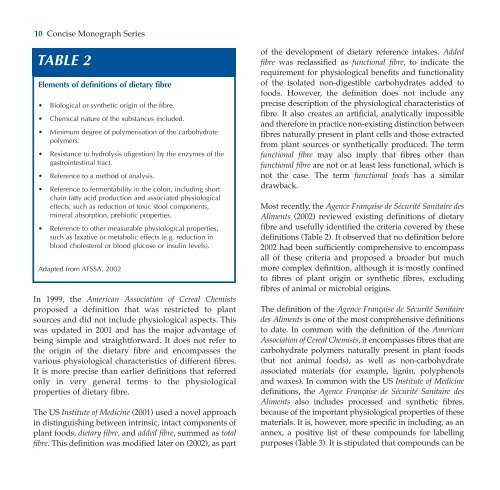Dietary Fibre - ILSI Argentina
Dietary Fibre - ILSI Argentina
Dietary Fibre - ILSI Argentina
Create successful ePaper yourself
Turn your PDF publications into a flip-book with our unique Google optimized e-Paper software.
10 Concise Monograph Series<br />
TABLE 2<br />
Elements of definitions of dietary fibre<br />
• Biological or synthetic origin of the fibre.<br />
• Chemical nature of the substances included.<br />
• Minimum degree of polymerisation of the carbohydrate<br />
polymers.<br />
• Resistance to hydrolysis (digestion) by the enzymes of the<br />
gastrointestinal tract.<br />
• Reference to a method of analysis.<br />
• Reference to fermentability in the colon, including short<br />
chain fatty acid production and associated physiological<br />
effects, such as reduction of toxic stool components,<br />
mineral absorption, prebiotic properties.<br />
• Reference to other measurable physiological properties,<br />
such as laxative or metabolic effects (e.g. reduction in<br />
blood cholesterol or blood glucose or insulin levels).<br />
Adapted from AFSSA, 2002<br />
In 1999, the American Association of Cereal Chemists<br />
proposed a definition that was restricted to plant<br />
sources and did not include physiological aspects. This<br />
was updated in 2001 and has the major advantage of<br />
being simple and straightforward. It does not refer to<br />
the origin of the dietary fibre and encompasses the<br />
various physiological characteristics of different fibres.<br />
It is more precise than earlier definitions that referred<br />
only in very general terms to the physiological<br />
properties of dietary fibre.<br />
The US Institute of Medicine (2001) used a novel approach<br />
in distinguishing between intrinsic, intact components of<br />
plant foods, dietary fibre, and added fibre, summed as total<br />
fibre. This definition was modified later on (2002), as part<br />
of the development of dietary reference intakes. Added<br />
fibre was reclassified as functional fibre, to indicate the<br />
requirement for physiological benefits and functionality<br />
of the isolated non-digestible carbohydrates added to<br />
foods. However, the definition does not include any<br />
precise description of the physiological characteristics of<br />
fibre. It also creates an artificial, analytically impossible<br />
and therefore in practice non-existing distinction between<br />
fibres naturally present in plant cells and those extracted<br />
from plant sources or synthetically produced. The term<br />
functional fibre may also imply that fibres other than<br />
functional fibre are not or at least less functional, which is<br />
not the case. The term functional foods has a similar<br />
drawback.<br />
Most recently, the Agence Française de Sécurité Sanitaire des<br />
Aliments (2002) reviewed existing definitions of dietary<br />
fibre and usefully identified the criteria covered by these<br />
definitions (Table 2). It observed that no definition before<br />
2002 had been sufficiently comprehensive to encompass<br />
all of these criteria and proposed a broader but much<br />
more complex definition, although it is mostly confined<br />
to fibres of plant origin or synthetic fibres, excluding<br />
fibres of animal or microbial origins.<br />
The definition of the Agence Française de Sécurité Sanitaire<br />
des Aliments is one of the most comprehensive definitions<br />
to date. In common with the definition of the American<br />
Association of Cereal Chemists, it encompasses fibres that are<br />
carbohydrate polymers naturally present in plant foods<br />
(but not animal foods), as well as non-carbohydrate<br />
associated materials (for example, lignin, polyphenols<br />
and waxes). In common with the US Institute of Medicine<br />
definitions, the Agence Française de Sécurité Sanitaire des<br />
Aliments also includes processed and synthetic fibres,<br />
because of the important physiological properties of these<br />
materials. It is, however, more specific in including, as an<br />
annex, a positive list of these compounds for labelling<br />
purposes (Table 3). It is stipulated that compounds can be

















